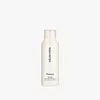What's inside
What's inside
 Key Ingredients
Key Ingredients

 Benefits
Benefits

 Concerns
Concerns

 Ingredients Side-by-side
Ingredients Side-by-side

Zea Mays Starch
AbsorbentSodium Cocoyl Isethionate
CleansingSodium Lauroyl Glutamate
Sodium Palmitate
CleansingDiglycerin
HumectantJuglans Regia Shell Powder
AbrasiveOryza Sativa Powder
Citric Acid
BufferingPanax Ginseng Root Extract
EmollientRosmarinus Officinalis Leaf Extract
AntimicrobialScutellaria Baicalensis Root Extract
AstringentTricholoma Matsutake Extract
Skin ConditioningAngelica Keiskei Leaf/Stem Extract
Skin ConditioningOryza Sativa Extract
AbsorbentPortulaca Oleracea Extract
Skin ConditioningArbutin
AntioxidantRice Ferment Filtrate
Skin ConditioningGossypium Herbaceum Extract
Skin ConditioningLactobionic Acid
BufferingAllantoin
Skin ConditioningMaltodextrin
AbsorbentPapain
Skin ConditioningWater
Skin ConditioningGlycerin
HumectantButylene Glycol
HumectantSodium Benzoate
MaskingParfum
MaskingZea Mays Starch, Sodium Cocoyl Isethionate, Sodium Lauroyl Glutamate, Sodium Palmitate, Diglycerin, Juglans Regia Shell Powder, Oryza Sativa Powder, Citric Acid, Panax Ginseng Root Extract, Rosmarinus Officinalis Leaf Extract, Scutellaria Baicalensis Root Extract, Tricholoma Matsutake Extract, Angelica Keiskei Leaf/Stem Extract, Oryza Sativa Extract, Portulaca Oleracea Extract, Arbutin, Rice Ferment Filtrate, Gossypium Herbaceum Extract, Lactobionic Acid, Allantoin, Maltodextrin, Papain, Water, Glycerin, Butylene Glycol, Sodium Benzoate, Parfum
Water
Skin ConditioningSodium Methyl Cocoyl Taurate
CleansingPolyglyceryl-3 Methylglucose Distearate
EmulsifyingGlycerin
HumectantAcrylates Copolymer
Glycol Distearate
EmollientSodium Hydroxypropyl Starch Phosphate
AbrasiveStearic Acid
CleansingSucrose Cocoate
EmulsifyingInulin
Skin ConditioningGlycolipids
Skin ConditioningSimmondsia Chinensis Seed Oil
EmollientSodium PCA
HumectantLactobacillus Ferment Lysate
Skin ConditioningLimnanthes Alba Seed Oil
Skin ConditioningPrunus Armeniaca Kernel Oil
MaskingGlyceryl Caprylate
Emollient1,2-Hexanediol
Skin ConditioningEthylhexylglycerin
Skin ConditioningLauric Acid
CleansingMyristic Acid
CleansingSodium Hydroxide
BufferingAlpha-Glucan Oligosaccharide
CleansingPolyquaternium-39
Caprylhydroxamic Acid
Tocopheryl Acetate
AntioxidantTrisodium Ethylenediamine Disuccinate
Propanediol
SolventLeuconostoc/Radish Root Ferment Filtrate
AntimicrobialSodium Benzoate
MaskingGlyceryl Undecylenate
EmollientSodium Hyaluronate
HumectantXanthan Gum
EmulsifyingWater, Sodium Methyl Cocoyl Taurate, Polyglyceryl-3 Methylglucose Distearate, Glycerin, Acrylates Copolymer, Glycol Distearate, Sodium Hydroxypropyl Starch Phosphate, Stearic Acid, Sucrose Cocoate, Inulin, Glycolipids, Simmondsia Chinensis Seed Oil, Sodium PCA, Lactobacillus Ferment Lysate, Limnanthes Alba Seed Oil, Prunus Armeniaca Kernel Oil, Glyceryl Caprylate, 1,2-Hexanediol, Ethylhexylglycerin, Lauric Acid, Myristic Acid, Sodium Hydroxide, Alpha-Glucan Oligosaccharide, Polyquaternium-39, Caprylhydroxamic Acid, Tocopheryl Acetate, Trisodium Ethylenediamine Disuccinate, Propanediol, Leuconostoc/Radish Root Ferment Filtrate, Sodium Benzoate, Glyceryl Undecylenate, Sodium Hyaluronate, Xanthan Gum
 Reviews
Reviews

Ingredients Explained
These ingredients are found in both products.
Ingredients higher up in an ingredient list are typically present in a larger amount.
Glycerin is already naturally found in your skin. It helps moisturize and protect your skin.
A study from 2016 found glycerin to be more effective as a humectant than AHAs and hyaluronic acid.
As a humectant, it helps the skin stay hydrated by pulling moisture to your skin. The low molecular weight of glycerin allows it to pull moisture into the deeper layers of your skin.
Hydrated skin improves your skin barrier; Your skin barrier helps protect against irritants and bacteria.
Glycerin has also been found to have antimicrobial and antiviral properties. Due to these properties, glycerin is often used in wound and burn treatments.
In cosmetics, glycerin is usually derived from plants such as soybean or palm. However, it can also be sourced from animals, such as tallow or animal fat.
This ingredient is organic, colorless, odorless, and non-toxic.
Glycerin is the name for this ingredient in American English. British English uses Glycerol/Glycerine.
Learn more about GlycerinSodium Benzoate is a preservative. It's used in both cosmetic and food products to inhibit the growth of mold and bacteria. It is typically produced synthetically.
Both the US FDA and EU Health Committee have approved the use of sodium benzoate. In the US, levels of 0.1% (of the total product) are allowed.
Sodium benzoate works as a preservative by inhibiting the growth of bacteria inside of cells. It prevents the cell from fermenting a type of sugar using an enzyme called phosphofructokinase.
It is the salt of benzoic acid. Foods containing sodium benzoate include soda, salad dressings, condiments, fruit juices, wines, and snack foods.
Studies for using ascorbic acid and sodium benzoate in cosmetics are lacking, especially in skincare routines with multiple steps.
We always recommend speaking with a professional, such as a dermatologist, if you have any concerns.
Learn more about Sodium BenzoateWater. It's the most common cosmetic ingredient of all. You'll usually see it at the top of ingredient lists, meaning that it makes up the largest part of the product.
So why is it so popular? Water most often acts as a solvent - this means that it helps dissolve other ingredients into the formulation.
You'll also recognize water as that liquid we all need to stay alive. If you see this, drink a glass of water. Stay hydrated!
Learn more about Water